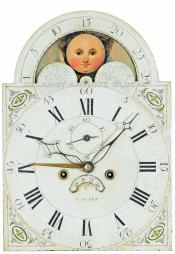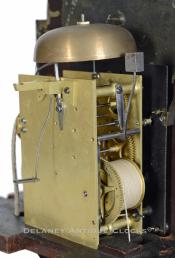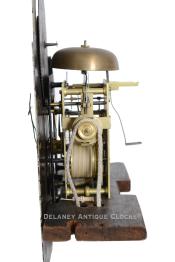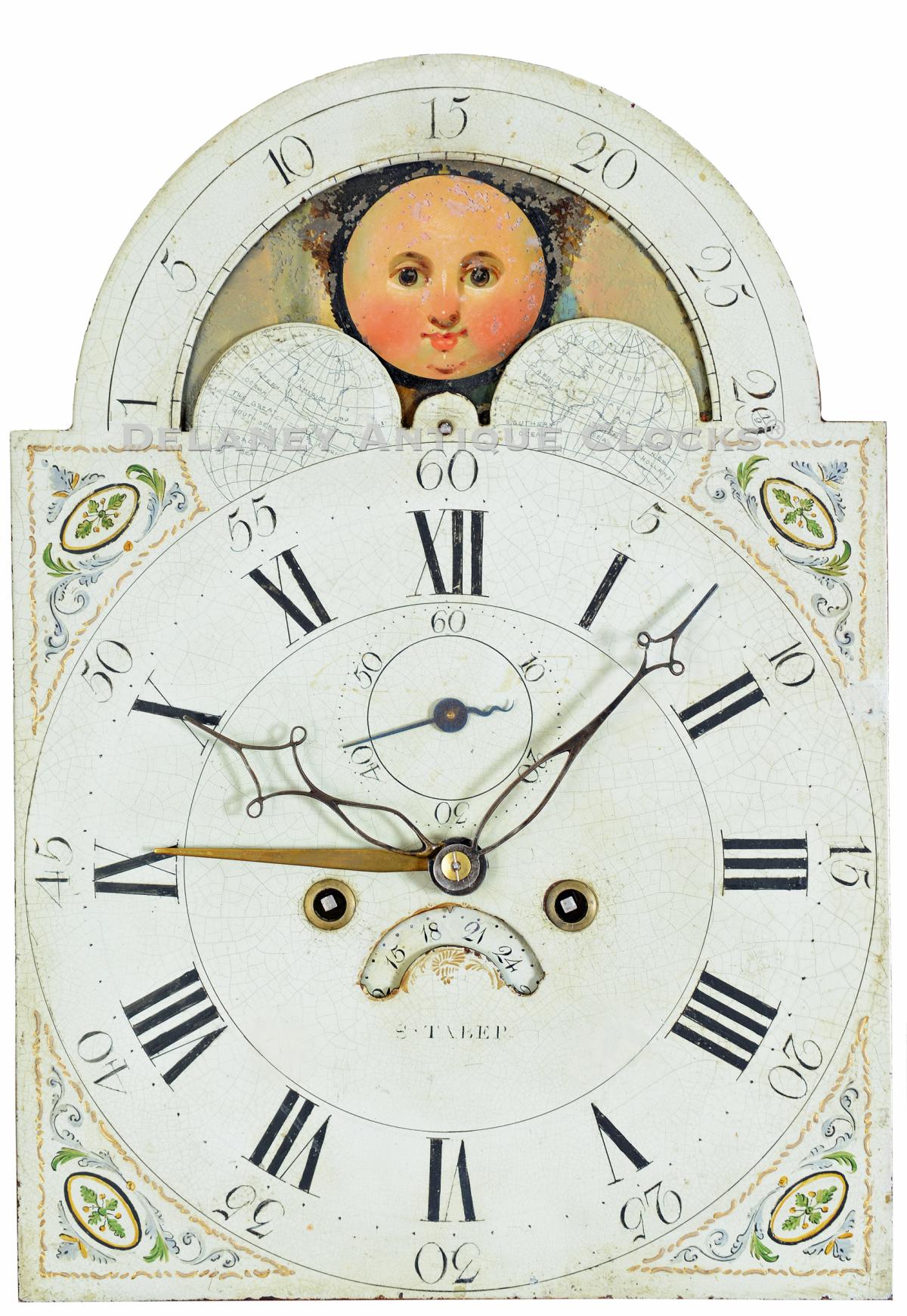Stephen Taber. New Bedford, Massachusetts. A testament to exquisite craftsmanship, this commanding tall clock features a lunar calendar dial and an alarm, a true masterpiece of its time. ZZ-60
This richly veneered clock has a commanding presentation. The case is wonderfully proportioned, with long, slender lines. It is constructed in mahogany and decorated with satinwood or birch panels and she-oak banding. The secondary wood is white pine. The contrast in color between the light brown mahogany wood and the honey-yellow satinwood is excellent. This formatting stands out and attracts one's attention from across the room.
The case stands on four nicely shaped or flared French feet. They form a drop apron below the base panel. Along the outer edge, the base is framed with a narrow band of She-oak. This decorative wood is found in numerous Southern Massachusetts cases. The base panel is complex, showcasing the maker's attention to detail.. The center oval is a selection of mahogany with a knot, and its grain pattern radiates outward on concentric bands like the cosmos. It is framed in a satinwood panel that features ovolo corners. The outer mahogany framing is formatted as cross-banding. The waist is long and narrow, accentuating this case's narrow proportions. The front corners of the waist are fitted with long fluted quarter columns that terminate in brass quarter capitals. The rectangular posts below the columns are faced with crotch satinwood panels. The center of this waist section features a rectangular-shaped waist door that shares the design used in the base panel, except that it is elongated. This door is trimmed with a simple rounded molding of she-oak. The door opens to access the two drive weights and the brass-faced pendulum. This door locks closed with a key. Satinwood panels are also positioned above and below this waist door. The bonnet is topped with delicate cut fretwork, which has a beautiful design. The three capped plinths are faced in satinwood. Each supports a brass ball and spike finial. The fully turned bonnet columns are fluted and mounted in brass capitals and flank the door. This bonnet door is an arched form. It is line inlaid, and the opening is fitted with glass. This door opens to a nicely paint-decorated dial.
This painted dial is signed by the Maker, "S. Taber," above the numeral six on the time track. A moon phase mechanism or lunar calendar is in the arch of this dial. The lunar calendar or moon phase mechanism is a mechanical almanac. This feature was most likely made on special order due to the extra work involved in producing it. This display would have been valuable to several occupations during the colonial era, a reminder of the practical uses of such a clock in the past. Farmers were known to track the moon phase to anticipate the days that offered the most available moonlight. A bright night would be more beneficial to them in scheduling the tilling and harvesting of their fields. Sailors and merchants track the lunar phases to know when the high tide would allow their ships to sail easily from a port or when the fishing might be best. Numerous religious groups had an almost superstitious litany of rituals best performed by lunar events. The lunar month represents an inconvenient interval of 29 days, 12 hours, 44 minutes, and 2.8 seconds. A tall clock's lunar calendar is set constant at 29.5 days, which represents a complete cycle. As a result, a 9-hour setback is required at the end of a single year to keep the lunar display current. The painted iron dial features unusual spandrel decorations. Floral swags surround floral-themed medallions. The colors are interesting. The combination of green, gold, and purple is uncommon. The time track is formatted with Arabic five-minute markers. These are separated from the Roman-style hours by a dotted minute ring. The seconds display, and the calendar dates are positioned in the traditional locations. Open diamond-stylized steel hands depict the time. One should notice a third hand of brass. This is used to set the alarm.
This movement is constructed in brass and is of good quality. Four-turned pillars support the two sizeable rectangular-shaped brass plates. Hardened steel shafts support the polished steel pinions, brass gearing, and recoil escapement. The winding drums are grooved. The weight-driven movement is designed to run for eight days on a full wind. It is a time-and-strike design with a rack-and-snail striking system. As a result, it will strike each hour on the hour on a cast iron bell mounted above the movement. This movement is also fitted with an alarm, the mechanism for which it is mounted to the right side of the works. It is wound independently of the main mechanics of the clock. One winds this alarm by pulling a cord inside the case, raising the drive weight. The alarm is set by moving the brass alarm hand, seen on the dial, to the desired time. When set up, it will strike multiple times rapidly on the hour bell until the alarm weight is exhausted. This very unusual feature is not often found on American tall case clocks, making this clock a truly unique and exclusive piece for any collector.
This clock was made circa 1810. It is a living relic of our rich history.
Dimensions: 99 inches tall, 20 inches wide, and 10.5 inches deep.
Inventory number ZZ-60.
Stephen Taber was born on October 23, 1777, in New Bedford, Massachusetts, and died there on September 10, 1862. His older brother Elnathan was nine years his senior and had moved North to Roxbury, where he served his clockmaking apprenticeship under Simon Willard. Simon considered Elnathan a highly skilled mechanic and his best apprentice. Elnathan remained in Roxbury after his indenture and continued to build clocks for himself and others in the Roxbury group of Clockmakers. Because of Elnathan's success, it is logical to assume that Stephen was also attracted to the clockmaking community in Roxbury. Stephen was trained in Boston by Aaron Willard, Simon's younger brother. By 1798, Stephen is recorded in the town of Roxbury's Tax Records as a Roxbury resident. This would suggest that he moved to Roxbury to start his apprenticeship sometime in 1791-92 at the age of 14. After serving his apprenticeship, he stayed in Roxbury for one year and returned to New Bedford in 1799. Here he advertised in October of that year that "Stephen Taber, (Late apprentice to Mr. Aaron Willard, Clock-Maker in Boston) Respectfully informs the public That he carries on the Clock Making Business... at his shop in Union Street..." From this time until he died in 1862, it appears that he lived and worked primarily in New Bedford. He is also listed as working in Acushnet for a short time. Over the later part of his life, the extent of his clockmaking trickled off as the years passed. This is assumed because he was more commonly listed as a merchant or trader by 1810. By 1860, his estate was valued at over $100,000. At the time of his death in 1862, his wealth had almost doubled. He married Elizabeth Sprague Pitcher in 1824. After he died in 1862, she became a philanthropist. She was one of the founding members of Tabor Academy in the town of Marion.











